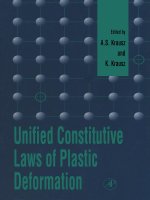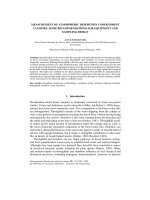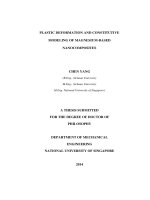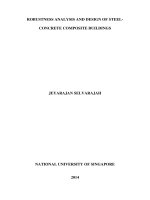Constitutive relationship of plain concrete under uniaxial load
Bạn đang xem bản rút gọn của tài liệu. Xem và tải ngay bản đầy đủ của tài liệu tại đây (2 MB, 219 trang )
CONSTITUTIVE RELATIONSHIP OF PLAIN
CONCRETE UNDER RAPID UNIAXIAL LOAD
LIU DING
NATIONAL UNIVERSITY OF SINGAPORE
2005
CONSTITUTIVE RELATIONSHIP OF PLAIN
CONCRETE UNDER RAPID UNIAXIAL LOAD
LIU DING
(M.Eng.)
A THESIS SUBMITTED
FOR THE DEGREE OF DOCTOR OF PHILOSOPHY
DEPARTMENT OF CIVIL ENGINEERING
NATIONAL UNIVERSITY OF SINGAPORE
2005
ACKNOWLEDGEMENT
The author wishes to express his most sincere appreciation and deep gratitude to
his academic supervisors, Assoc. Professor W.A.M. Alwis and Assoc. Professor Quek
Ser Tong for their invaluable guidance, patient encouragement and comments
throughout the course of this study.
In addition, special appreciation to National University of Singapore for the
support granted for this period of study.
Finally, but never the least, extremely thanks are presented to his family members
for their endless love and understanding.
TABLE OF CONTENTS
ACKNOWLEDGEMENT ……………………………………………………………………….
i
TABLE OF CONTENT ………………………………………………………………………….
ii
LIST OF TABLES………………………………………………………………………………
v
LIST OF FIGURES……………………………………………………………………………
viii
NOMENCLATURE……………………………………………………………………………
xvii
SUMMARY………………………………………………………………………………………
xx
CHAPTER 1
INTRODUCTION 1
1.1. General 1
1.2. Literature Review 3
1.2.1. Constitutive Modeling on Deformational Behaviour of Concrete 3
1.2.1.1. Introduction 4
1.2.1.2. Viscoelastic Models 5
1.2.1.3. Elastic / Viscoplastic Models 7
1.2.1.4. Endochronic Models 9
1.2.1.5. Damage Models 9
1.2.1.6. Discrete-Element Method (DEM) 10
1.2.2. Empirical Relationships 10
1.3. Aims and Objectives 13
1.3.1. Scope of Work 13
1.3.2. Thesis Layout 14
CHAPTER 2
LOADING RATE SENSITIVE BEHAVOUR OF CONCRETE AND CREEP MODELS 20
2.1. General 20
2.2. Comparison Between Creep and Dynamic Response of Concrete 20
2.2.1. Phenomenological Similarities 20
2.2.2. Similarities in Mechanism 22
2.2.2.1. The Microcracking Theory 22
2.2.2.2. Similarities 23
Table of Content iii
2.3. Creep Models 24
2.4. B3 Model 30
2.5. CEB 1990 Model 33
2.6. The Sakata Model 34
2.7. Elastic Deformation 35
2.7.1. Initial Modulus 35
2.7.2. Determination of Asymptotic Modulus 37
CHAPTER 3
APPLICATION OF CREEP MODELS FOR RAPID AXIAL COMPRESSION 42
3.1. General 42
3.2. Creep Strain Due To Varying Stress History 43
3.2.1. Effective Modulus Method (EM Method) 43
3.2.2. Method of Superposition 44
3.2.3. Rate of Creep Method (RC Method) 45
3.2.4. Rate of Creep Compliance Method (For the B3 Model Only) 47
3.3. Rapid Axial Compression Modelling 49
3.3.1. Computational Model 49
3.3.2. Time-Marching Calculation Algorithm 49
3.3.3. Convergence of the Simulation Results 53
CHAPTER 4
SIMULATION AND DISCUSSION 59
4.1. General 59
4.2. Variation of Secant Modulus 59
4.2.1. General 59
4.2.2. Stress-Time Paths 60
4.2.3. Characteristic Variation of Secant Modulus 61
4.2.4. Effects of Strains 61
4.2.5. Effect of Stress Path 62
4.2.6. Discussion 62
4.3. Rapid Axial Compression Experiments 63
4.3.1. Experimental Data 63
4.3.1.1. Deformational Characteristics 64
4.3.1.2. Strength Characteristics 64
4.4. Nonlinearity Of Stress-Strain Curves 65
4.4.1. Nonlinearity of Concrete Creep 65
4.4.2. Nonlinear Amplification of Creep Strain 66
4.4.3. Material Constatant λ 68
4.5. Simulation Results 70
4.5.1. Performance of Creep Models 71
4.5.2. Performance of Strategies for Creep Calculation 72
4.5.3. Performance of
λ
Expression 73
Table of Content iv
4.5.4. Comparison with CEB Emprical Formula 73
CHAPTER 5
APPLICATION OF CREEP MODELS FOR CYCLIC LOADING 99
5.1. General 99
5.2. Simulation On Cyclic Loading Test 99
5.2.1. Variation of Stress and Strain 99
5.2.2. Tentative Analysis 100
5.2.3. Simulations On Experiments 100
5.3. Discussions 101
5.3.1. Creep Model Performances 101
5.3.2. Creep Calculation Strategies Performances 103
CHAPTER 6
CONCLUSION AND RECOMMENDATION 113
6.1. General 113
6.2. Conclusions 113
6.3. Recommendations 114
REFERENCES 116
PUBLICATION 130
APPENDIX 131
LIST OF TABLES
Table 3.1 Convergence of Simulation Results – B3 Model, Rate of Creep
Compliance Method
55
Table 3.2 Convergence of Simulation Results – CEB Model, RC Method 55
Table 3.3 Convergence of Simulation Results –Sakata Model, RC Method 55
Table 4.1 Labels of Loading Cases For Secant Modulus Study 75
Table 4.2 Figures Numbers for Different Loading Paths For Secant Modulus Study 75
Table 4.3 Mix Details and Basic Information for Bischoff & Perry Test 75
Table 4.4 Test Results for Bischoff & Perry Test 76
Table 4.5 Mix Details and Basic Information for Ahmad Test 77
Table 4.6 Test Results for Ahmad Test 77
Table 4.7 Summary of The Experiments Selected For Simulation 78
Table 4.8 Specimen Parameters 79
Table 4.9
Best Fit Material Parameter
λ
80
Table 4.10
Coefficients for Expression of
λ
81
Table 4.11
Results of Simulation – Logarithmic
λ
Expression, B3 Model, Rate of
Creep Compliance Method
82
Table 4.12
Results of Simulation – Logarithmic
λ
Expression, B3 Model, Rate of
Creep Method
83
Table 4.13
Results of Simulation – Logarithmic
λ
Expression, B3 Model,
Superposition Method
84
Table 4.14
CEB Empirical Formula Results and Creep Model Simulation
(B3Model, Rate of Creep Compliance Method)
85
List of Table vi
Table 4.15
CEB Empirical Formula Results and Creep Model Simulation
(CEB Model, Rate of Creep Method)
86
Table 4.16
CEB Empirical Formula Results and Creep Model Simulation
(Sakata Model, Superposition Rate of Creep Method)
87
Table 5.1 Summary of the Repeated Loading Tests 170
Tables listed in Appendix
App-1
Results of Simulation – Logarithmic
λ
Expression, CEB Model, Rate of
Creep Method
133
App-2
Results of Simulation – Logarithmic
λ
Expression, CEB Model,
Superposition Method
134
App-3
Results of Simulation – Logarithmic
λ
Expression, Sakata Model, Rate of
Creep Method
135
App-4
Results of Simulation – Logarithmic
λ
Expression, Sakata Model,
Superposition Method
136
App-5
Results of Simulation – Linear
λ
Expression, B3 Model, Rate of Creep
Compliance Method
137
App-6
Results of Simulation – Linear
λ
Expression, B3 Model, Rate of Creep
Method
138
App-7
Results of Simulation – Linear
λ
Expression, B3 Model, Superposition
Method
139
App-8
Results of Simulation – Linear
λ
Expression, CEB Model, Rate of Creep
Method
140
App-9
Results of Simulation – Linear
λ
Expression, CEB Model, Superposition
Method
141
List of Table vii
App-10
Results of Simulation – Linear
λ
Expression, Sakata Model, Rate of Creep
Method
142
App-11
Results of Simulation – Linear
λ
Expression, Sakata Model, Superposition
Method
143
App-12
Results of Simulation –
λ
=5, B3 Model, Rate of Creep Compliance
Method
144
App-13
Results of Simulation –
λ
=5, B3 Model, Rate of Creep Method
145
App-14
Results of Simulation –
λ
=5, B3 Model, Superposition Method
146
App-15
Results of Simulation –
λ
=7, CEB Model, Rate of Creep Method
147
App-16
Results of Simulation –
λ
=7, CEB Model, Superposition Method
148
App-17
Results of Simulation –
λ
=6, Sakata Model, Rate of Creep Method
149
App-18
Results of Simulation –
λ
=6, Sakata Model, Superposition Method
150
LIST OF FIGURES
Figure 1.1 Magnitude of Stain Rates with Respect to Different Loading Cases 15
Figure 1.2
Typical Stress-Strain Relationship of Concrete under Different Loading
Rates
15
Figure 1.3
Basic Mechanical Constitutive Model Units 16
Figure 1.4
Maxwell Model 16
Figure 1.5
Deformation Response of Maxwell Model 17
Figure 1.6
Kelvin Model 17
Figure 1.7
Deformation Response of Kelvin Model 18
Figure 1.8
Burgers Model 18
Figure 1.9
Deformation Response of Burgers Model 19
Figure 1.10
Typical Stress-Strain Relation For Concrete 19
Figure 2.1
Strain Development of Concrete under Creep Phenomena 39
Figure 2.2 Components of Concrete Deformation at Creep 39
Figure 2.3 Components of Concrete Deformation Under Rapid Load 40
Figure 2.4 General form of Strain-time Curve for Concrete Subjected to Creep 40
Figure 2.5 Initial Modulus of Creep Models 41
Figure 2.6 Flow Chart For Determination of Asymptotic Elastic Modulus 41
Figure 3.1 Stress History Effect On Effective Modulus Method 56
Figure 3.2 Scheme for Superposition Method 57
Figure 3.3 Displacement of Elements 58
List of Figures ix
Figure 3.4 Discretized Representation of the Specimen 58
Figure 3.5 Flow Chart of Simulation 59
Figure 4.1 Loading Paths of Analysis for Secant Modulus 88
Figure 4.2
Graph for Mix B under Loading Case L0-A 89
Figure 4.3
Graph for Mix B under Loading Case L0-B 89
Figure 4.4
Graph for Mix B under Loading Case L1-A 90
Figure 4.5
Graph for Mix B under Loading Case L1-B 90
Figure 4.6
Effect of Loading Paths (Mix B) 91
Figure 4.7
Effect of Loading Paths (Mix C) 91
Figure 4.8
Effect of Loading Paths (Mix II) 92
Figure 4.9
Effect of Loading Paths (Mix IV) 92
Figure 4.10
Comparison with Test and Simulation Data (Mix B) 93
Figure 4.11
Comparison with Test and Simulation Data (Mix C) 93
Figure 4.12
Comparison with Test and Simulation Data (Mix II) 94
Figure 4.13
Comparison with Test and Simulation Data (Mix IV) 94
Figure 4.14
Nonlinear Multiplier of BP-KX Model 95
Figure 4.15
Curves of
ν
versus
ε
According to Relationship
λ
ε
ν
)1000(=
95
Figure 4.16
Relation Between
λ
and Compressive Strength for B3 Model
(Logarithmic)
96
Figure 4.17
Relation Between
λ
and Cement Content for B3 Model (Logarithmic)
96
Figure 4.18
Results of Simulation - Logarithmic
λ
Expression, B3 Model, Rate of
Creep Compliance Method, Test 1
97
Figure 4.19
Results of Simulation - Logarithmic
λ
Expression, B3 Model, Rate of
Creep Method, Test 1
97
Figure 4.20
Results of Simulation - Logarithmic
λ
Expression, B3 Model,
98
List of Figures x
Superposition Method, Test 1
Figure 4.21
Results of Simulation - Logarithmic
λ
Expression, CEB Model, Rate of
Creep Method, Test 1
98
Figure 4.22
Results of Simulation - Logarithmic
λ
Expression, CEB Model,
Superposition Method, Test 1
99
Figure 5.1
Stress and Stain Paths
105
Figure 5.2
Simulated Stress-Strain Curves for Strain-Controlled Cyclic Loading
106
Figure 5.3
Simulated Stress-Strain Curves for Stress-Controlled Cyclic Loading
106
Figure 5.4
Simulated Stress-Strain Curves for Repeat Loading Case C-R4, B3
Model, Rate of Creep Compliance Method
107
Figure 5.5
Simulated Stress-Strain Curves for Repeat Loading Case C-R7, B3 Model,
Rate of Creep Compliance Method
107
Figure 5.6
Simulated Stress-Strain Curves for Repeat Loading Case C-R4, B3 Model,
Rate of Creep Method
108
Figure 5.7
Simulated Stress-Strain Curves for Repeat Loading Case C-R7, B3 Model,
Rate of Creep Method
108
Figure 5.8
Simulated Stress-Strain Curves for Repeat Loading Case C-R4, B3 Model,
Superposition Method
109
Figure 5.9
Simulated Stress-Strain Curves for Repeat Loading Case C-R7, B3 Model,
Superposition Method
109
Figure 5.10
Simulated Stress-Strain Curves for Repeat Loading Case C-R4, CEB
Model, Rate of Creep Method
110
Figure 5.11
Simulated Stress-Strain Curves for Repeat Loading Case C-R7, CEB
Model, Rate of Creep Method
110
Figure 5.12
Simulated Stress-Strain Curves for Repeat Loading Case C-R4, CEB
110
List of Figures xi
Model, Superposition Method
Figure 5.13
Simulated Stress-Strain Curves for Repeat Loading Case C-R7, CEB
Model, Superposition Method
111
Figure 5.14
Simulated Stress-Strain Curves for Repeat Loading Case C-R4, Sakata
Model, Rate of Creep Method
111
Figure 5.15
Simulated Stress-Strain Curves for Repeat Loading Case C-R7, Sakata
Model, Rate of Creep Method
112
Figure 5.16
Simulated Stress-Strain Curves for Repeat Loading Case C-R4, Sakata
Model, Superposition Method
112
Figure 5.17
Simulated Stress-Strain Curves for Repeat Loading Case C-R7, Sakata
Model, Superposition Method
113
Figures listed in Appendix
App-A1
Graph for Mix B under Loading Case S0-A
151
App-A2
Graph for Mix B under Loading Case S0-B
151
App-A3
Graph for Mix B under Loading Case S1-A
152
App-A4
Graph for Mix B under Loading Case S1-B
152
App-A5
Graph for Mix B under Loading Case IS0-A
153
App-A6
Graph for Mix B under Loading Case IS0-B
153
App-A7
Graph for Mix B under Loading Case IS1-A
154
App-A8
Graph for Mix B under Loading Case IS1-B
154
App-A9
Graph for Mix B under Loading Case LM-A
155
App-A10
Graph for Mix B under Loading Case LM-B
155
App-A11
Graph for Mix C under Loading Case L0-A
156
App-A12
Graph for Mix C under Loading Case L0-B
156
List of Figures xii
App-A13
Graph for Mix C under Loading Case L1-A
157
App-A14
Graph for Mix C under Loading Case L1-B
157
App-A15
Graph for Mix C under Loading Case S0-A
158
App-A16
Graph for Mix C under Loading Case S0-B
158
App-A17
Graph for Mix C under Loading Case S1-A
159
App-A18
Graph for Mix C under Loading Case S1-B
159
App-A19
Graph for Mix C under Loading Case IS0-A
160
App-A20
Graph for Mix C under Loading Case IS0-B
160
App-A21
Graph for Mix C under Loading Case IS1-A
161
App-A22
Graph for Mix C under Loading Case IS1-B
161
App-A23
Graph for Mix C under Loading Case LM-A
162
App-A24
Graph for Mix C under Loading Case LM-B
162
App-A25
Graph for Mix II under Loading Case L0-A
163
App-A26
Graph for Mix II under Loading Case L0-B
163
App-A27
Graph for Mix II under Loading Case L1-A
164
App-A28
Graph for Mix II under Loading Case L1-B
164
App-A29
Graph for Mix II under Loading Case S0-A
165
App-A30
Graph for Mix II under Loading Case S0-B
165
App-A31
Graph for Mix B under Loading Case S1-A
166
App-A32
Graph for Mix II under Loading Case S1-B
166
App-A33
Graph for Mix II under Loading Case IS0-A
167
App-A34
Graph for Mix II under Loading Case IS0-B
167
App-A35
Graph for Mix II under Loading Case IS1-A
168
App-A36
Graph for Mix II under Loading Case IS1-B
168
App-A37
Graph for Mix II under Loading Case LM-A
169
List of Figures xiii
App-A38
Graph for Mix II under Loading Case LM-B
169
App-A39
Graph for Mix IV under Loading Case L0-A
170
App-A40
Graph for Mix IV under Loading Case L0-B
170
App-A41
Graph for Mix IV under Loading Case L1-A
171
App-A42
Graph for Mix IV under Loading Case L1-B
171
App-A43
Graph for Mix IV under Loading Case S0-A
172
App-A44
Graph for Mix IV under Loading Case S0-B
172
App-A45
Graph for Mix IV under Loading Case S1-A
173
App-A46
Graph for Mix IV under Loading Case S1-B
173
App-A47
Graph for Mix IV under Loading Case IS0-A
174
App-A48
Graph for Mix IV under Loading Case IS0-B
174
App-A49
Graph for Mix IV under Loading Case IS1-A
175
App-A50
Graph for Mix IV under Loading Case IS1-B
175
App-A51
Graph for Mix IV under Loading Case LM-A
176
App-A52
Graph for Mix IV under Loading Case LM-B
176
App-B1
Relation Between
λ
and Water Content for B3 Model (Logarithmic)
177
App-B2
Relation Between
λ
and Sand Content for B3 Model (Logarithmic)
177
App-B3
Relation Between
λ
and Density for B3 Model (Logarithmic)
178
App-B4
Relation Between
λ
and Compressive Strength for CEB Model
(Logarithmic)
178
App-B5
Relation Between
λ
and Cement Content for CEB Model (Logarithmic)
179
App-B6
Relation Between
λ
and Water Content for CEB Model (Logarithmic)
179
App-B7
Relation Between
λ
and Sand Content for CEB Model (Logarithmic)
180
App-B8
Relation Between
λ
and Density for CEB Model (Logarithmic)
180
List of Figures xiv
App-B9
Relation Between
λ
and Compressive Strength for Sakata Model
(Logarithmic)
181
App-B10
Relation Between
λ
and Cement Content for Sakata Model
(Logarithmic)
181
App-B11
Relation Between
λ
and Water Content for Sakata Model (Logarithmic)
182
App-B12
Relation Between
λ
and Sand Content for Sakata Model (Logarithmic)
182
App-B13
Relation Between
λ
and Density for Sakata Model (Logarithmic)
183
App-B14
Relation Between
λ
and Compressive Strength for B3 Model (Linear)
183
App-B15
Relation Between
λ
and Cement Content for B3 Model (Linear)
184
App-B16
Relation Between
λ
and Water Content for B3 Model (Linear)
184
App-B17
Relation Between
λ
and Sand Content for B3 Model (Linear)
185
App-B18
Relation Between
λ
and Density for B3 Model (Linear)
185
App-B19
Relation Between
λ
and Compressive Strength for CEB Model (Linear)
186
App-B20
Relation Between
λ
and Cement Content for CEB Model (Linear)
186
App-B21
Relation Between
λ
and Water Content for CEB Model (Linear)
187
App-B22
Relation Between
λ
and Sand Content for CEB Model (Linear)
187
App-B23
Relation Between
λ
and Density for CEB Model (Linear)
188
App-B24
Relation Between
λ
and Compressive Strength for Sakata Model
(Linear)
188
App-B25
Relation Between
λ
and Cement Content for Sakata Model (Linear)
189
App-B26
Relation Between
λ
and Water Content for Sakata Model (Linear)
189
App-B27
Relation Between
λ
and Sand Content for Sakata Model (Linear)
190
App-B28
Relation Between
λ
and Density for Sakata Model (Linear)
190
App-C1
Results of Simulation - Logarithmic
λ
Expression, Sakata Model, Rate of
191
List of Figures xv
Creep Method, Test 1
App-C2
Results of Simulation - Logarithmic
λ
Expression, Sakata Model,
Superposition Method, Test 1
191
App-C3
Results of Simulation - Logarithmic
λ
Expression, B3 Model, Rate of
Creep Compliance Method, Test 2
192
App-C4
Results of Simulation - Logarithmic
λ
Expression, B3 Model, Rate of
Creep Method, Test 2
192
App-C5
Results of Simulation - Logarithmic
λ
Expression, B3 Model,
Superposition Method, Test 2
193
App-C6
Results of Simulation - Logarithmic
λ
Expression, CEB Model, Rate of
Creep Method, Test 2
193
App-C7
Results of Simulation - Logarithmic
λ
Expression, CEB Model,
Superposition Method, Test 2
194
App-C8
Results of Simulation - Logarithmic
λ
Expression, Sakata Model, Rate of
Creep Method, Test 2
194
App-C9
Results of Simulation - Logarithmic
λ
Expression, Sakata Model,
Superposition Method, Test 2
195
App-C10
Results of Simulation - Logarithmic
λ
Expression, B3 Model, Rate of
Creep Compliance Method, Test 17
195
App-C11
Results of Simulation - Logarithmic
λ
Expression, B3 Model, Rate of
Creep Method, Test 17
196
App-C12
Results of Simulation - Logarithmic
λ
Expression, B3 Model,
Superposition Method, Test 17
196
App-C13
Results of Simulation - Logarithmic
λ
Expression, CEB Model, Rate of
Creep Method, Test 17
197
List of Figures xvi
App-C14
Results of Simulation - Logarithmic
λ
Expression, CEB Model,
Superposition Method, Test 17
197
App-C15
Results of Simulation - Logarithmic
λ
Expression, Sakata Model, Rate of
Creep Method, Test 17
198
App-C16
Results of Simulation - Logarithmic
λ
Expression, Sakata Model,
Superposition Method, Test 17
198
NOMENCLATURE
c
A
Cross-section of the Specimen member
a
Specific contents of aggregate of concrete
)',( ttC
Specific creep function
0
C
Creep compliance rate
c
Specific contents of cement of concrete
C
Creep strain vector of the system in integration
D
The damping matrix
sec
E
Secant modulus
cd
E
Dynamic compression modulus
cs
E
Static compression modulus
td
E
Dynamic tension modulus
ts
E
Static tension modulus
cmto
E
Modulus of elastic at age of loading
0
E
Asymptotic elastic modulus
'
28cm
f
Concrete mean compressive strength at 28 day
'
cmto
f
Concrete mean compressive strength at loading
cmo
f
Constant, 10 MPa in CEB-FIP 1990 model
g
Degree of hydration at loading for B-3 model
H
K
Degree of hydration at loading
K
c
The creep matrix
K
The stiffness matrix
Nomenclature xviii
M
The mass matrix
1
q
Elastic compliance of the B-3 model
2
q
Aging viscoelastic compliance the B-3 model
3
q
Non-aging viscoelastic compliance the B-3 model
4
q
Flow compliance the B-3 model
RH
Relative humidity (%)
s
Specific contents of sand of concrete
t
Current age
t’
Age of loading
1
t
Constant, 1 day in CEB-FIP 1990 model
u
Perimeter of the member in contract with the atmosphere
V
a
Volume concentration of aggregate
V
uc
Volume concentration of un-hydrated cement
V
cp
Volume concentration of cement paste
SV
Volume to surface area ratio (mm)
w
Specific contents of water of concrete
s
x
Deformation of spring in Maxwell and Kelvin constitutive
m
d
x
Deformation of dashpot in Maxwell and Kelvin cons
t
M
ν
Viscosity of dashpot in Maxwell constitutive model
M
α
Compliance of spring in Maxwell constitutive model
K
ν
Viscosity of dashpot in Kelvin constitutive model
K
α
Compliance of spring in Kelvin constitutive model
η
Retardation time of Kelvin constitutive model
ε
Strain
Nomenclature xix
ε
Strain rate
c
ε
Creep strain
c
ε
Creep strain rate
bc
'
ε
Specific basic creep for Sakata model
dc
'
ε
Specific drying creep for Sakata model
σ
Stress
)',( ttΦ
Specific secant modulus function
)',( tt
φ
Creep coefficient
c
ρ
Unit mass of concrete
j
i
δ
Displacement of node j at step i
j
i
δ
Speed of node j at step i
j
i
δ
Acceleration of node j at step i
λ
Material constant in nonlinear multiplier expression
µ
Nonlinear multiplier
ν
Coefficient in nonlinear multiplier
χ
Material constant in nonlinear multiplier expression
SUMMARY
Creep models are usually rate-type constitutive models and in the case of
concrete creep models, they had originally been developed for the prediction of
long-term deformation. Potential exploitation of similarities between the
dynamic and creep behaviour of concrete is the focus of the present work. An
attempt is made here to extend the application of creep theories to modelling of
concrete behaviour under rapid uniaxial loading.
Three creep models, namely CEB model, B3 model and Sakata Model,
were chosen for simulating the behaviour of concrete under various rates of rapid
loading. Two creep calculation strategies, namely the rate of creep method and
superposition method, were applied for calculating creep. In addition, another
method developed specially for the B-3 model was implemented as well. As a
key contribution in the present work, a new creep multiplier term is proposed and
implemented to enable modelling of strain-softening and unloading response. To
establish the applicability of the creep models under rapid loading conditions as
well as to determine the level of accuracy rendered by the computational
approach adopted, a wide range of reported experiments were simulated. The
experimental results are compared with simulated results obtained. It is apparent
from comparisons that the creep model could be used to simulate the axial stress-
strain relationship of concrete under different rates of loading fairly satisfactorily.
Keywords: creep, dynamic, rate of loading, compressive strength, secant
modulus, strain rate, uniaxial loading
- 1 -
CHAPTER 1
INTRODUCTION
1.0
1.1. GENERAL
The mechanical behaviour of most materials is known to be influenced significantly
by the rate of loading. The quest for knowledge about the influence of loading rate on the
behaviour of materials goes beyond the confines of scientific curiosity, driven by important
practical engineering needs.
Structures are often subjected to transient dynamic loads. These dynamic loads may
result, for instance, from impact by air blast, wind gusts, accidental collision and
earthquake loading. The strain rates associated with impact or other similar loading, are
typically one million times higher than those usually associated with static loading (see
Figure 1.1). Most engineering materials, when subjected to such high strain rates, will
exhibit some changes in their response, indicating variations in material properties such as
strength, stiffness, and ductility. Generally, these changes would enhance their engineering
performance, enabling structures to withstand impact loading better than one would have
otherwise expected (Bischoff and Perry 1991).
In order to design structural components well, engineers need to understand the
material behaviour and thereby be able to predict structural performance. Given the
behavioural complexity of impact response, computational models of material behaviour
are preferred by engineers. Material behaviour in such instances is characterised by the
relationship among stress, stress rate, strain and strain rate.
Concrete is a loading rate sensitive material of great engineering significance.
However, the understanding on dynamic behaviour of concrete is still not understood
Chapter 1 Introduction
- 2 -
sufficiently (Bischoff and Perry 1991). On the other hand, a great deal of knowledge on the
long-term deformational behaviours of concrete, in terms of the phenomena known as
creep and shrinkage, has been accumulated. Many theoretical models also have been
developed for long-term deformation of concrete (Mehta 1993). The primary interest of this
study is to investigate the potential use of the established knowledge on the long terms
behaviour of concrete for predicting behaviour of concrete over very short time periods
under dynamic conditions.
The loading rate sensitive behaviour of concrete and its constituents has been under
investigation for a long time. Initially, most researchers studying high strain-rate effects of
concrete have been concerned with the increase of strength. Many experiments have been
performed to observe the variation of strength under rapid loading (Bischoff and Perry
1991). Some theories and empirical expressions for the increase of concrete strength with
the rate of loading have been suggested in some of these studies. With this emphasis
mainly on observed strength increases, little or no attention had been paid to the changes in
deformational behaviour under rapid loading.
From the viewpoint of engineering mechanics, the elastic stiffness of material is a key
parameter that determines the deformational response. It controls the natural frequency
spectrum of a given structure and therefore determining the overall response of the
structure under the action of any impact load. An assessment of such response would be
important especially in cases where the relevant serviceability requirements are stringent.
In extreme cases of long span or slim structures,
∆
−
P effects caused by large deformation
could even lead to catastrophic consequence.
It is generally accepted that the elastic modulus and strength of concrete will increase
with increasing of strain rate (see Figure 1.2). Nevertheless, a form of an explicit
relationship between strain / stress rate and the elastic modulus / strength has not yet been
established, a primary reason being the broad scatter of available experimental results.
Chapter 1 Introduction
- 3 -
Empirical relationships between elastic modulus / strength and strain rates tend to be
logarithmic (Ahmad 1981, Konig and Dargel 1982, Parviz. et al. 1986, CEB 1988).
However, each of such relationships has been found to relate to a limited scope of
experimental results.
Some theoretical models that could explain the enhancement of concrete stiffness
and strength have been proposed. Examples are the visco-elastic theory (Flugge 1975),
plastic-fracture theory (Bazant and Kim 1979) and the endochronic theory (Bazant and
Bhat 1976). Certain fracture theories attribute this property of concrete to the micro-
cracking at the mortar-coarse aggregate interface. According to these explanations, the
decrease of internal micro-cracking with increase of strain rate is the main reason for the
increase of dynamic elastic modulus. Some endochronic theories regard the visco-elastic
property of concrete as the source of the increase of dynamic elastic modulus. The higher
the strain rate, the lesser the development of viscous deformation concrete develops. Such
variations in deformation are manifested as variations in elastic modulus. Elastic /
viscoplastic theories have also been applied in explaining the dynamic elastic modulus. In
terms of applicability, the disadvantages of such theories are the limitation of their
applicable ranges or the high degree of complexities.
1.2. LITERATURE REVIEW
The prediction of the dynamic elastic modulus and strength of concrete subjected to
rapid loading has been addressed in some reported tests. Some theoretical constitutive
models and empirical formulas have also been proposed. Several cases are discussed in the
following.
1.2.1. Constitutive Modeling on Deformational Behaviour of Concrete









